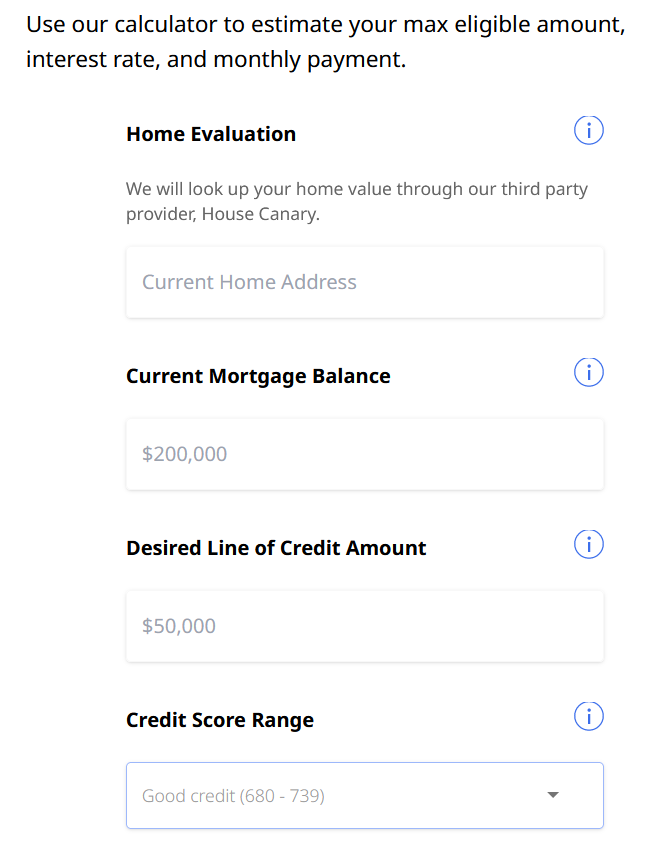Determine Your Borrowing Capacity and Calculate HELOC Payments
Key Takeaways:
A HELOC loan calculator provides information on borrowing capacity and payment calculations.
The amount you can borrow with a HELOC loan depends on factors such as equity, credit, and income.
You can use the calculator to estimate interest rates and potential savings from improving your credit score.
Table of Contents
-
Using a HELOC Calculator
-
Recommendation
-
Other Factors to Consider with HELOCs
-
The Difficulty of Obtaining a HELOC or Home Equity Loan
Get a quick estimate of your HELOC amount and payments in just 20 seconds with our Calculator.
A home equity line of credit (HELOC) is a mortgage that uses your home as collateral. HELOCs are a cost-effective source of funds and can be suitable for various purposes. Our HELOC calculator helps answer important questions such as, "How much can I borrow with a HELOC on my home?" and "What might my HELOC payment be?" You can even estimate current interest rates based on your credit rating and explore potential savings by improving it.
Using a HELOC Calculator
Our home equity line of credit calculator is simple to use. You only need four pieces of information: your property address, current mortgage balance, desired loan amount, and credit score range. Based on your inputs, the calculator generates a maximum loan amount, interest rate, and monthly mortgage payment.
Step one: Home Evaluation
Enter your property address so that House Canary, a third-party valuation service, can estimate your home's value. If House Canary doesn't have data on your home or if you want to adjust the estimate, you can manually input your property value.
Step two: Current mortgage balance
Determine the total amount you currently owe on your home, which includes all outstanding mortgage balances. This includes your primary mortgage, existing HELOCs, home equity loans, and purchase money second mortgages. Note that if you plan to refinance a home equity loan or HELOC with a new loan, exclude that balance from the total.
Step three: Desired loan amount
Specify how much you would like to borrow with a HELOC. In most cases, the maximum amount you can borrow from HELOC lenders is 80% of your home value minus your existing loan balances. If your desired loan amount exceeds this limit, you'll receive an error message and will need to enter a lower amount.
Step four: Credit score range
Your credit score influences the interest rate offered by HELOC lenders. You can obtain your FICO or VantageScore from your credit card companies or for free from Experian.com. Select the credit score tier that matches your score.
Recommendation
As you scroll down, the calculator provides a recommended loan amount, estimated interest rate, and monthly payment for both the HELOC draw period and the repayment period.
Loan amount
The calculator displays your desired line of credit and also reveals the maximum line of credit based on your estimated property value and outstanding mortgage balance. It's important to note that while this calculator assumes a maximum loan-to-value (LTV) ratio of 80%—as most HELOC lenders do—individual lenders may allow higher amounts, particularly if you are highly qualified. Conversely, if your credit rating is poor or your debts are high relative to your income, lenders may limit your loan amount.
Monthly Payment
This section provides an estimate of your monthly HELOC payment. You can choose between two payment options in the drop-down menu: the draw period payment and the repayment period payment. Both payments assume you take the maximum available credit at closing and only pay the minimum due each month.
It's important to understand that paying more or borrowing less will save you money.
Note that you can opt to make the minimum monthly payment for up to ten years. However,
if you only make the minimum payment, your loan balance will not decrease.
When you enter the repayment period of your HELOC, the minimum amount will increase to ensure the loan amortizes (is paid off) over the remaining term. With a 30-year HELOC, the repayment period is typically 20 years. The calculator assumes your balance equals your desired loan amount when entering the repayment phase.
Other Factors to Consider with HELOCs
The calculator provides estimates only, and there are additional considerations when applying for a loan:
The interest rate assumption is based on average HELOC rates from various lenders and is not an offer or commitment to lend. Mortgage rates are tied to financial market movements and can change without notice. Furthermore, HELOC lenders base their offers on your complete application, not just a few estimates.
The calculator assumes a constant interest rate. Traditional HELOCs typically have variable interest rates, meaning your monthly payment can change periodically. However, some lenders now offer fixed-rate HELOCs that function more like home equity loans. With this option, you can draw your entire HELOC credit line at closing and make fixed, fully amortizing home equity loan payments for the entire loan term, saving money and avoiding payment increases after ten years.
Qualifying for a HELOC depends on factors beyond LTV and credit score. Your overall creditworthiness influences the amount a specific lender is willing to offer, which can be more or less than the calculator shows.
The Difficulty of Obtaining a HELOC or Home Equity Loan
When applying for a HELOC, mortgage lenders assess your income, debts, credit history, employment history, and property value. Lenders are required by law to verify that you can afford your mortgage payment, including a HELOC.
Credit score
Excellent FICO scores usually lead to the best HELOC rates, and if your debt-to-income ratio is favorable, you may be able to borrow up to 90% of your home value.
For good-to-excellent credit scores and the ability to afford the loan, you can secure a competitive interest rate and borrow against 80% of your property value. However, if your score is fair-to-poor, lenders may only lend against 75% or less of your property value, assuming your income is reliable and your debts are reasonable.
For most lenders to approve a HELOC, your debt-to-income ratio should not exceed 43%. This means your total debt payments, including the HELOC repayment period payment, should not exceed 43% of your before-tax monthly income.
Using a portion of your loan proceeds for debt consolidation can help reduce your debt-to-income ratio. Debt consolidation involves using your HELOC to pay off other debts, typically those with higher interest rates and larger payments.



